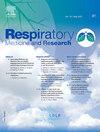囊性纤维化患者补充药物和自我药疗的应用MUCAUTOMED研究
IF 1.8
4区 医学
Q3 RESPIRATORY SYSTEM
引用次数: 0
摘要
囊性纤维化(CF)患者通常接受CFTR调节剂治疗,CFTR调节剂已证明具有较高的疗效,但也可能涉及药物相互作用。图卢兹大学医院的病人和处方者经常询问药物与补充和替代药物产品(CAMp)和自我药疗药物相互作用的风险。目前,在CF患者中缺乏这些实践的文献,特别是在法国,自CFTR调节剂出现以来更是如此。方法本观察性单中心研究(MUCAUTOMED)旨在描述和量化我院CF患者CAMp使用率。第二个目的是评估和描述自我药疗实践的流行程度。对2022年1月10日至6月6日就诊的门诊患者进行调查。结果在171例纳入的患者中,分析了64例成人和69例儿童的反应(有效率133/171 = 77.8%)。56.3%的成年人和46.4%的儿童使用CAMp。大多数患者使用CAMp来增强健康,解决消化问题和管理呼吸问题。值得注意的是,71.4%的参与者不知道潜在的药物与CAMp的相互作用,48.9%的人在没有咨询医疗保健专业人员的情况下开始使用CAMp。值得注意的是,在儿科人群中发现了CAMp使用与自我用药之间的显著相关性。结论:我们的调查强调了CF人群中CAMp使用的显著高流行率。鉴于这些发现,在开始CFTR调节剂治疗时,常规讨论CAMp的使用和自我用药实践是必要的。建议采用多学科方法来解决可能影响过量和剂量不足的潜在相互作用,确保患者和家属了解相关风险。注册号2021-A02593-38。本文章由计算机程序翻译,如有差异,请以英文原文为准。
Use of complementary medicines and self-medication practices in cystic fibrosis – MUCAUTOMED study
Background
Cystic fibrosis (CF) patients often undergo treatment with CFTR modulators, which have demonstrated high efficacy but also potential involvement in drug interactions. Inquiries regarding the risks of drug interactions with complementary and alternative medicine products (CAMp) and self-medication drugs have become frequent among patients and prescribers at Toulouse University Hospital. Currently, there is lack of literature on these practices within CF patients, particularly in France, and more so since the advent of CFTR modulators.
Methods
This observational monocentric study (MUCAUTOMED) aimed to characterize and quantify the prevalence of CAMp utilization among CF patients under our hospital's care. A secondary objective was to assess and describe the prevalence of self-medication practices. Surveys were administered to outpatients during visits from January 10 to June 6, 2022.
Results
Out of 171 included patients, responses from 64 adults and 69 children were analyzed (response rate 133/171 = 77.8 %). CAMp usage was reported by 56.3 % of adults and 46.4 % of children. Most patients use CAMp for enhancing wellness, addressing digestive concerns, and managing respiratory issues. Remarkably, 71.4 % of participants were unaware of potential drug interactions with CAMp, and 48.9 % initiated such use without consulting healthcare professionals. Notably, a significant correlation between CAMp utilization and self-medication was identified within the pediatric population.
Conclusion
Our investigation underscores a notably high prevalence of CAMp use among the CF population. Given these findings, it is imperative to routinely discuss CAMp utilization and self-medication practices when initiating CFTR modulator therapy. A multidisciplinary approach is recommended to address potential interactions that may impact overdosing and underdosing, ensuring patients and families are informed of associated risks.
Registration number 2021-A02593-38.
求助全文
通过发布文献求助,成功后即可免费获取论文全文。
去求助
来源期刊

Respiratory Medicine and Research
RESPIRATORY SYSTEM-
CiteScore
2.70
自引率
0.00%
发文量
82
审稿时长
50 days
 求助内容:
求助内容: 应助结果提醒方式:
应助结果提醒方式:


